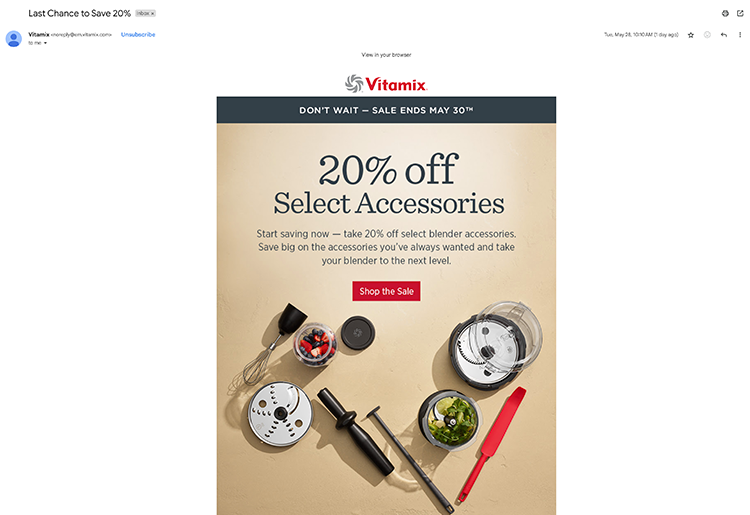 Written by Anna Sonnenberg Written by Anna Sonnenberg  Reviewed by Noa Kaufman Reviewed by Noa KaufmanLast Update: {month} {year} Email marketing is a method for promoting a business via email campaigns. With email, businesses can improve brand awareness, generate leads, drive sales, increase customer loyalty, and much more. Compared to other marketing channels, email provides a remarkably high return on investment (ROI). In fact, for every $1 spent, email marketing generates an ROI of $36. As a result, email is an essential marketing channel for many small and midsize businesses (SMBs). In this article, we'll cover how to create an email marketing strategy and share best practices for SMBs. How to Create an Email Marketing StrategyFollow the five steps below to develop an email marketing strategy. 1. Define Your Email Marketing GoalsFirst, get clear on what you want to accomplish with this channel. Your email marketing goals will affect the software you'll use and the types of campaigns you'll run. Here are a few examples to jumpstart the process:
2. Choose an Email Marketing PlatformNext, pick the right email marketing software for your needs. Consider factors like:
3. Build Your Email ListAfter choosing the software, begin building your list of email addresses. Email marketing is a permission-based channel, which means subscribers must opt-in to receive your messages. Some of the best ways to collect email addresses include:
For example, Bombas offers a 20% discount for signing up for the brand's email list.  4. Design Email CampaignsOnce you've attracted subscribers, you're ready to send marketing emails. Most email marketing tools offer predesigned templates that you can customize with your company's messaging. Let's look at a few different types of emails to include in your strategy. Email NewslettersNewsletters keep current and potential customers in the loop about company news, products, and services (like the Everlane email below). They can also include snippets from blog posts or links to premium resources.  Automated Email SequencesMarketing automations are triggered based on subscriber actions. For example, welcome emails go to new subscribers, and abandoned cart emails (like the Asics email below) go to customers who didn't finish checking out.  Sending these emails is more important than you might think. According to the Omnisend Email, SMS, and Push Marketing Statistics for Ecommerce in 2024 report, "Automated emails generated 41% of all email orders while accounting for only 2% of emails sent." Promotional EmailsPromotional emails highlight sales, discounts, and offers (like the Vitamix email below). They're typically time-sensitive, and they often include promo or discount codes. Think of them as a method of advertising by email.  Transactional EmailsTransactional emails include purchase, order or subscription details (like the Canva email below). Ecommerce companies may also include shipping details in these email automations.  5. Review Your Email AnalyticsIs your small business email marketing strategy working? Your email analytics can give you a definitive answer. All email marketing platforms (like Mailchimp in the example below) provide data like open rate, click rate, and unsubscribe rate.  But the most important metrics to monitor are those related to your goals. For example, if you want to drive more sales, pay attention to clicks and orders.  Optimize your strategy using this data. For example, find the email that led to the most orders or the highest ROI. Then, use it as a model to craft more high-performing messages for your audience. Email Marketing Best Practices to FollowUse these four tips for more effective email marketing. Split Test Email ElementsNot sure if a certain subject line or email layout will lead to better results? Use A/B testing to create multiple versions of an email and send each to part of your list. Then, use the results to continue to create better emails. Personalize Your EmailsAdd personalization to emails automatically using dynamic content. For example, you can insert subscribers' names to greet them or highlight products they buy frequently to encourage them to repurchase. "Personalized emails still outperform generic ones, but you’ll need to go beyond the standard personalized salutation to deliver truly engaging communications," advises Michal Leszczynski, Head of Content Marketing & Partnerships at Get Response, in the company's 2023 Email Marketing Benchmarks report. Use SegmentationNot everyone on your list will benefit from receiving every email campaign. Segment your audience to ensure you only send relevant emails to subscribers. This tactic can improve open and click rates. Optimize for DeliverabilityThe higher your deliverability rate, the better chance you have of getting your emails in subscribers' inboxes. As a result, maintaining high deliverability is one of the keys to success for email marketing for small businesses. This metric is particularly important in 2024 due to spam prevention measures by Google and Yahoo. ActiveCampaign recommends setting up DKIM email authentication, maintaining spam complaints below 0.1%, and cleaning your email list regularly to remove inactive subscribers.Our Methodology for Researching Email MarketingAuthored by Anna Sonnenberg, an expert in marketing technology, this article draws from extensive research and first-hand experience with email marketing strategies. Anna gathered insights and data from industry-leading sources and research reports. Sources include research from top email marketing platforms: ActiveCampaign, GetResponse, Litmus, and Omnisend. Next Steps to Get Started With Email MarketingTo succeed with email marketing, you need the right goals, a solid list, and the right software. Find the email marketing platform that best fits your business and start connecting with your customers today. About Anna Sonnenberg: SaaS ExpertAnna Sonnenberg is a seasoned B2B SaaS writer and small business owner. Specializing in martech, sales automation, and productivity software, Anna turns complex topics into clear, actionable insights. As a fellow entrepreneur, she's dedicated to helping you harness the right tools to grow your business. |
|